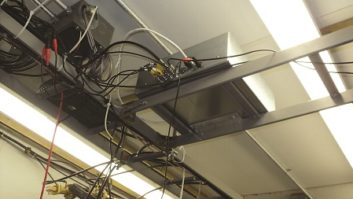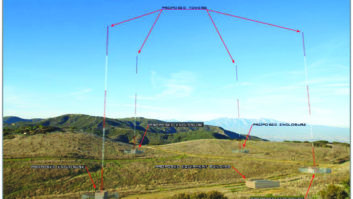Tower Light Alarm Circuit
Jan 24, 2003 12:00 PM, By Grady Moates
Accurate tower light monitoring is a serious matter, and great care can be taken to install a thorough and automatic monitoring system. Designing a system to provide a single-lamp failure can quickly fill several status channels on a facility’s transmitter remote control system if one status input is dedicated to each lamp monitor circuit. Here is a method to spare the extra status channels and instead use a single telemtry channel to provide the same level of lamp resolution.
This pseudo-binary system uses a series of diodes and relay contacts to vary the indicated voltage. The parts needed:
1K, 1W resistor
12vdc power supply
7 diodes, 1N4005 are used here
3 SSAC tower light monitor modules
The SSAC tower light monitor modules have floating form C relay contacts. These are installed so that the relay contacts are closed when the lights are off. The 1N4005 diodes have higher reverse-voltage and forward-current ratings than this circuit requires, but because they are so inexpensive, the higher ratings provide additional insurance against failure.
The relay contacts in the diagram are connected as follows:
S1 – Top beacon
S2 – Center beacon
S3 – Side markers
Because the voltage drop across the diode junction is 0.7 volts, the resulting output voltage of the circuit can easily identify which lights are on or off. When all the tower lights are off, the circuit output is zero volts. When only the side lights are on, the circuit output is 0.7 volts. When only the center beacon is on, the circuit output is 1.4 volts. When only the top beacon is on, the circuit output 2.8 volts.
Because the diodes and switches are in series, the voltages will add if more than one relay is open. Calibrate the remote control telemetry input for any desired multiplication factor. A handy reference in this example would be to set an input voltage of 0.7 volts to provide a 100mv reading. With this, the resulting telemetry readings based on the lamp condition would be:
0 Volts = All Lights OFF
100 = side lights ON, both beacons OUT
200 = center beacon ON, top beacon and side lights OUT
300 = side lights and center beacon ON, top beacon OUT
400 = top beacon ON, center beacon and side lights OUT
500 = top beacon and side lights ON, center beacon OUT
600 = top beacon and center beacon ON, side lights OUT
700 = All lights ON
These divisions can also be used to set various alarm levels to indicate a lamp failure. If the reading drops below 650 but stays above 550, a single side marker is out. The FCC and FAA do not require notification of a single side marker, so this would be a warning indicator. However, if the reading drops below 550, a more serious alarm can be set because at least one beacon has failed.
This diode-string scheme could be continued with more switches and sets of diodes, but the next step would be require 8 diodes, and then 16 diodes and so on. This can quickly get out of hand. In an instance where more than 4 levels of metering are required, reverse-biased zener diodes would be a better choice.

Moates operates Loud and Clean, a company that designs, installs, optimizes and maintains radio broadcast antenna systems, transmission facilities, audio processing systems, digital storage and production facilities and studio architecture and acoustics. He is based in the Boston area. Reach him through http://www.loudandclean.com




